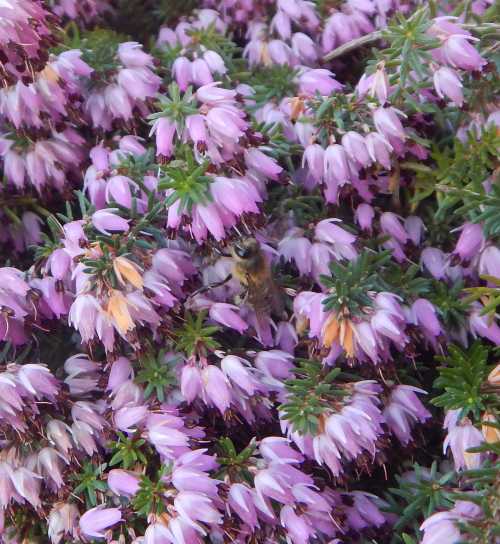Why Heathers Are Great For Bees
Heathers are hardy, evergreen shrubs and in gardens, they are especially useful in rockery areas. They are very popular with bees for their nectar, but they also supply pollen.
If you plan carefully, you can have heather in bloom in your garden from autumn until spring. They thrive in acidic soil.
Over the years I have had a number of heathers growing in my garden. For a variety of reasons, I now have only a couple: a winter flowering Erica - and indeed, this features in my recommendations of winter flowering shrubs for bees.
It has been in my garden for years, provides a clump of cheery white flowers in the rockery, and is visited by hungry bees, notably emerging queen bumble bees.

Honey bees are also frequent visitors. Some people enjoy heather honey as a mono-floral honey.
What are heathers?
It is considered that the 'heathers' group - part of the Ericaceae family of plants, includes Erica (heath), Calluna (heather) and Daboecia (Irish heath).
In the UK, The National Collection of Heathers, (which includes all three) is held at RHS Garden Wisley, showcasing over 1000 cultivars.
For bees, my particular favourites are the winter and early spring flowering Ericas, for the simple reason that they provide food for bees when foraging opportunities are relatively scarce, and so they are a useful addition to the bee garden.
However, the summer-autumn flowering heathers are certainly very popular with pollinators too.
Which bees and pollinators visit heather?

Heathers are not only popular with bees, other pollinators are attracted to the flowers.
A study in Belgium by Mahy et al1 identified at least 49 species of insects visiting the flowers of Calluna vulgaris at the study site.
All of the 329 identified insects belonged to the orders Hymenoptera (the insect order of bees, wasps, ants and sawflies), Diptera (flies), and Lepidoptera (moths and butterflies). Over the 2 year study period, Hymenoptera and Diptera were the principal visitors (44 and 47%, respectively).
Bumble bees (Bombus) and honey bees (Apis mellifera) were the most common visitors of the hymenoptera group, and a number of different bumble bee species were identified, including (in order of abundance):
- Bombus lucorum (white-tailed bumble bee).
- Bombus cryptarum (cryptic bumble bee).
- Bombus terrestris (buff-tailed bumble bee).
- Bombus soroensis pratensis (broken-belted bumble bee).
- Bombus magnus (northern white-tailed bumble bee).
- Psithyrus bohemicus (or Bombus bohemicus, the gypsy cuckoo bumble bee)
- Pyrobombus lapidarius (or Bombus lapidarius, the red-tailed bumble bee)
- Pyrobombus pratorum (or Bombus pratorum, the early bumble bee)
- Megabombus pascuorum floralis (common carder bumble bee)
Wasp and ant species also visited the heather.
Another study by Ballantyne et al2 provided an insight into the insect visitors to several plants over a given period, including Erica tetralix, Erica cinerea and Calluna vulgaris.
| Erica tetralix | Erica cinerea | Calluna vulgaris | |
|---|---|---|---|
| Bees |
Bombus terrestris | Bombus terrestris | Bombus terrestris |
| Bombus lucorum | Bombus lucorum | Bombus lucorum | |
| Bombus pascuorum | |||
| Bombus lapidarius | Bombus lapidarius | Bombus lapidarius | |
| Bombus jonellus | Bombus jonellus | ||
| Apis mellifera | Apis mellifera | Apis mellifera | |
| Halictidae | Halictidae | ||
| Other solitary bees | |||
| Flies |
Episyrphus | ||
| Eupeodes | Eupeodes | ||
| Large hoverflies | Large hoverflies | ||
| Small hoverflies | Small hoverflies | ||
| Muscidae | |||
| Soldier fly | |||
| Ants | Ants (Lasius) |
Likewise, Erica features on a large number of biodiversity recommendations as a beneficial group of shrubs for bees and pollinators3.
How heather provides valuable food for bees

I have managed to pick apart a couple of studies to provide examples of the nutrient value provided by heathers for pollinators.
Pollen content
In one study by Di Pasquale et al5, pollen from Erica (specific cultivars not provided) was found to have the 10 essential amino acids required for the bee adult development6: arginine, histidine, lysine, tryptophan, phenylalanine, methionine, threonine, leucine, isoleucine, and valine.
It was found that horse chestnut flowers and brambles (Rubus) had higher levels, but neither of these are likely candidates for the average garden.
Nectar
Heathers are a valuable source of nectar, and one study found that nectar composition of Ericas may vary, with varying levels of fructose, glucose and sucrose4.
References
1. Mahy, Grégory & Sloover, Jacques & Jacquemart, Anne-Laure. (2011). The generalist pollination system and reproductive success of Calluna vulgaris in the Upper Ardenne. Canadian Journal of Botany. 76. 1843-1851. 10.1139/b98-133.
2. Ballantyne, G., Baldock, K. C., & Willmer, P. G. (2015). Data from: Constructing more informative plant-pollinator networks: visitation and pollen deposition networks in a heathland plant community. [Dataset]. https://doi.org/10.5061/dryad.17pp3
3. For example, the RHS Plants For Pollinators list, and "THE ACTION PLAN FOR POLLINATORS SUGGESTED PLANT LIST FOR POLLINATORS" of the Welsh government.
4. Barnes, K., Nicolson, S., and Van Wyk, B. (1996). Nectar Sugar Composition in Erica. Biochemical Systematics and Ecology, Vol. 23, NO. 4, pp. 419-423.
5. Di Pasquale G, Salignon M, Le Conte Y, et al. Influence of pollen nutrition on honey bee health: do pollen quality and diversity matter?. PLoS One. 2013;8(8):e72016. Published 2013 Aug 5. doi:10.1371/journal.pone.0072016
6. de Groot AP (1953) Protein and amino acid requirements of the honey bee (Apis mellifica L.). Physiol Comp Oecol 3: . pp. 197-285.

